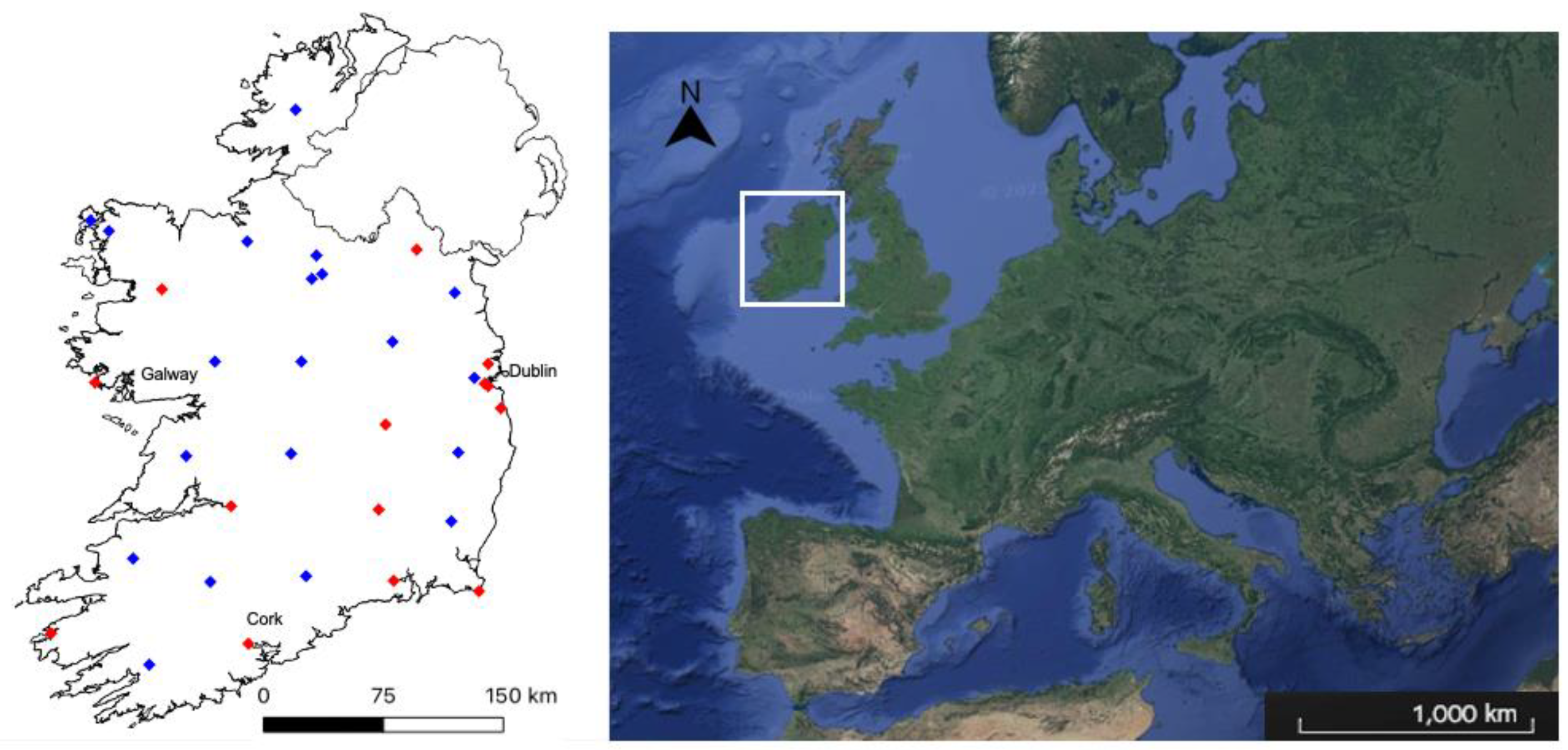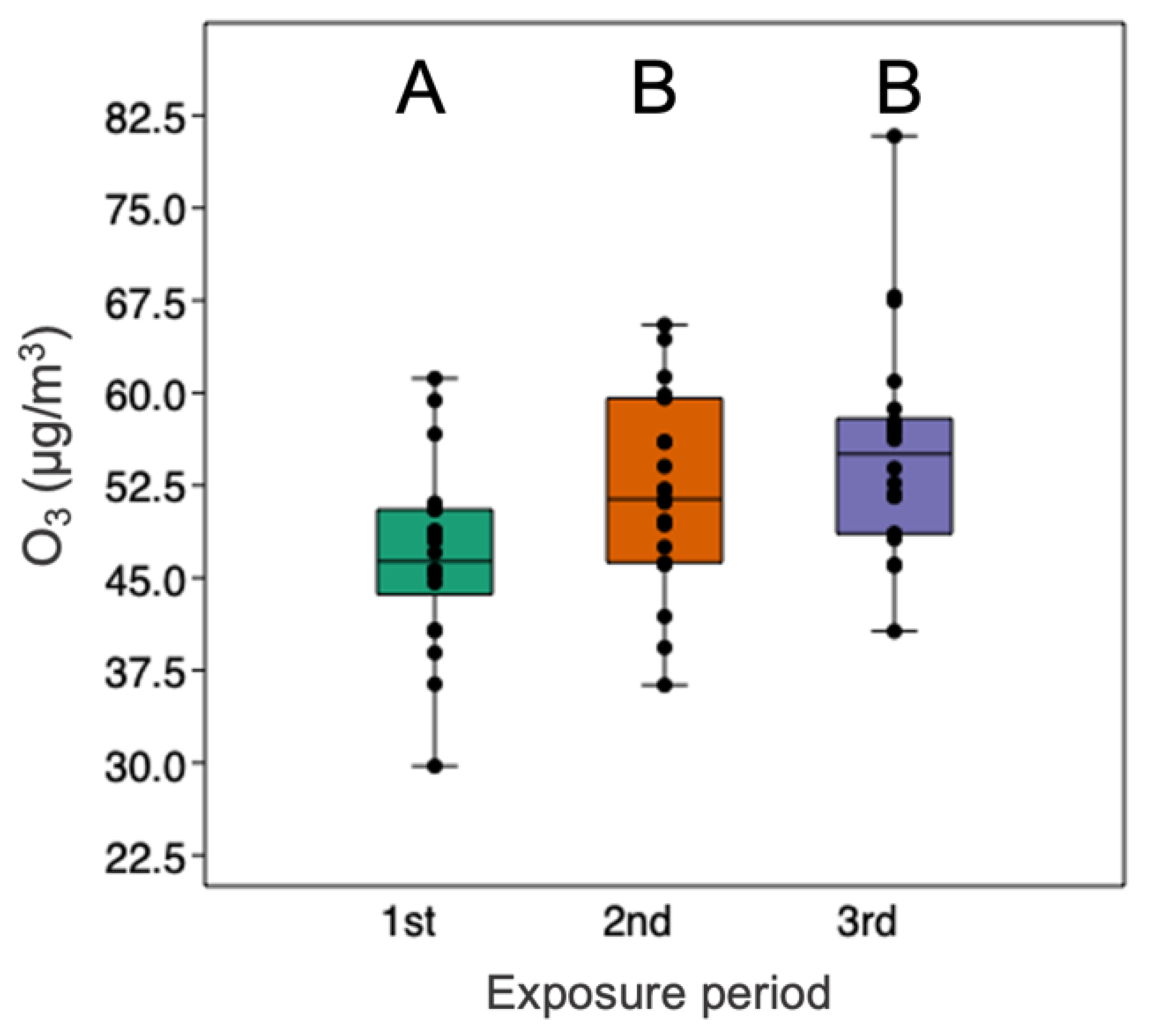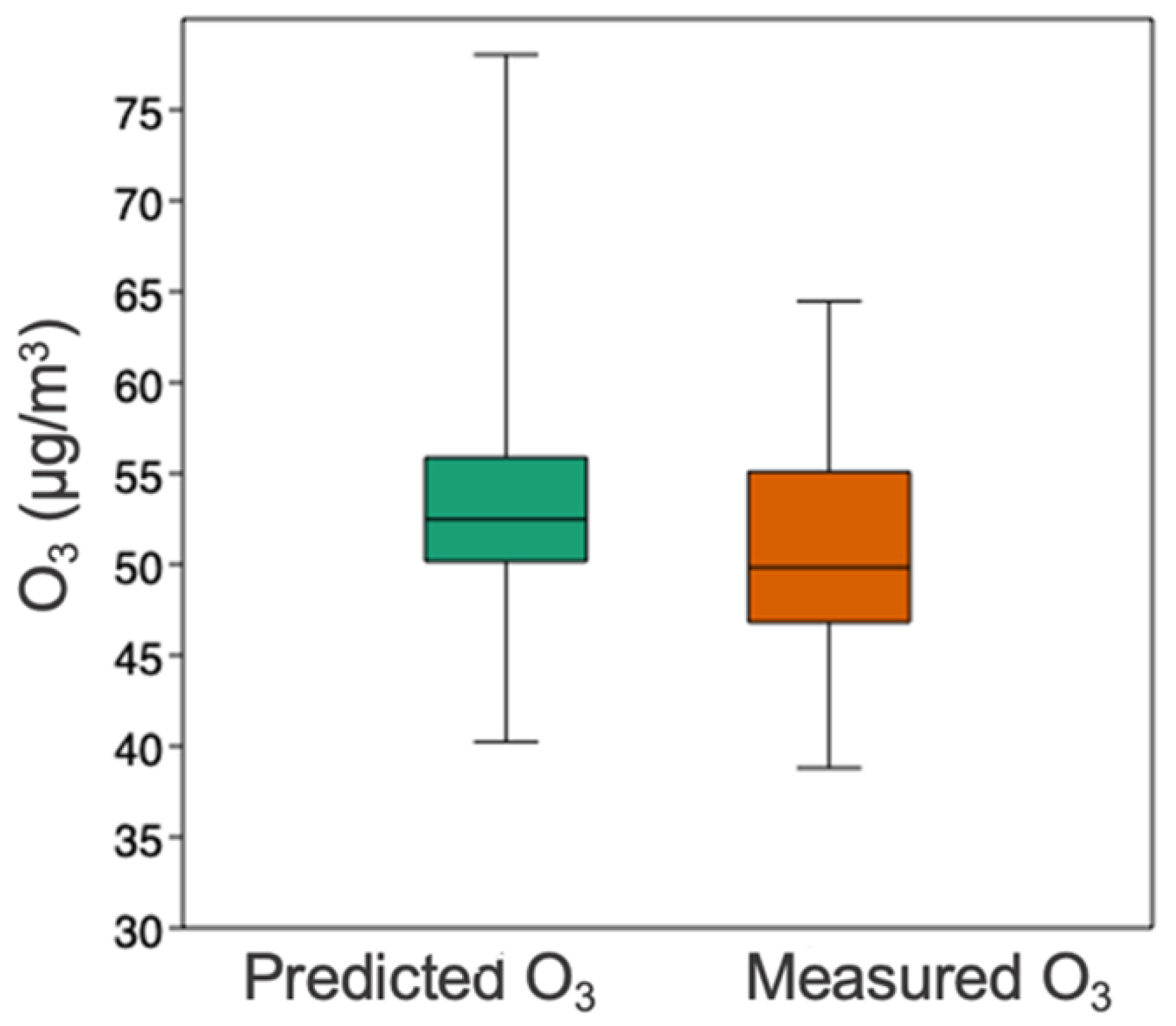Land-Use Regression Analysis of Summer Tropospheric Ozone Concentrations in Ireland
Abstract
:1. Introduction
2. Materials and Methods
2.1. Sample Site Selection
2.2. Measurement of Ozone
2.3. Characterising Locations by Landscape Features
2.4. Data Analysis and Model Building
3. Results and Discussion
3.1. Distributions of Measured Concentrations
3.2. Predictors of O3 in Ireland, and Insights from a Finer Spatial-Scale Concentration Map
3.2.1. Land-Use Regression Model
3.2.2. Modelled Ozone Concentrations
3.3. Land-Use Regression Studies
4. Conclusions
Supplementary Materials
Author Contributions
Funding
Institutional Review Board Statement
Informed Consent Statement
Data Availability Statement
Acknowledgments
Conflicts of Interest
References
- EEA. Health Effects of Exposure to Ozone; EEA Publications: Copenhagen, Denmark, 2016; Available online: https://www.eea.europa.eu/publications/TOP08-98/page010.html (accessed on 15 November 2023).
- World Health Organization. Review of Evidence on Health Aspects of Air Pollution: REVIHAAP Project: Technical Report (No. WHO/EURO: 2013–4101–43860-61757); World Health Organization, Regional Office for Europe: Geneva, Switzerland, 2021.
- Mills, G.; Wagg, S.; Harmens, H. Ozone Pollution: Impacts on Ecosystem Services and Viodiversity; NERC/Centre for Ecology & Hydrology: Lancaster, UK, 2013; Available online: https://nora.nerc.ac.uk/id/eprint/502675/ (accessed on 15 November 2023).
- Grulke, N.E.; Heath, R.L. Ozone effects on plants in natural ecosystems. Plant Biol. 2020, 22, 12–37. [Google Scholar] [CrossRef]
- Juráň, S.; Grace, J.; Urban, O. Temporal Changes in Ozone Concentrations and Their Impact on Vegetation. Atmosphere 2021, 12, 82. [Google Scholar] [CrossRef]
- Mills, G.; Pleijel, H.; Malley, C.S.; Sinha, B.; Cooper, O.R.; Schultz, M.G.; Neufeld, H.S.; Simpson, D.; Sharps, K.; Feng, Z.; et al. Tropospheric Ozone Assessment Report: Present-day tropospheric ozone distribution and trends relevant to vegetation. Elem. Sci. Anthr. 2018, 6, 47. [Google Scholar] [CrossRef]
- CLRTAP. Towards Cleaner Air. Scientific Assessment Report; Maas, R., Grennfelt, P., Eds.; EMEP Steering Body and Working Group on Effects of the Convention on Long-Range Transboundary Air Pollution: Olso, Norway, 2016; p. 50. [Google Scholar]
- EPA. Ireland’s Air Pollutant Emissions 1990–2030. Monotoring & Assessment: Climate Change; Air Emissions Publications: Wexford, Ireland, 2020. Available online: https://www.epa.ie/pubs/reports/air/airemissions/irelandsairpollutantemissions2018/EPA-Air-Pollutant-Emissions-website.pdf (accessed on 15 November 2023).
- Schumann, U.; Huntrieser, H. The global lightning-induced nitrogen oxides source. Atmos. Chem. Phys. 2007, 7, 3823–3907. [Google Scholar] [CrossRef]
- Sillman, S. The relation between ozone, NOx and hydrocarbons in urban and polluted rural environments. Atmos. Environ. 1999, 33, 1821–1845. [Google Scholar] [CrossRef]
- Tan, Z.; Lu, K.; Dong, H.; Hu, M.; Li, X.; Liu, Y.; Lu, S.; Shao, M.; Su, R.; Wang, H.; et al. Explicit diagnosis of the local ozone production rate and the ozone-NOx-VOC sensitivities. Sci. Bull. 2018, 63, 1067–1076. [Google Scholar] [CrossRef]
- Wang, P.; Chen, Y.; Hu, J.; Zhang, H.; Ying, Q. Attribution of Tropospheric Ozone to NOx and VOC Emissions: Considering Ozone Formation in the Transition Regime. Environ. Sci. Technol. 2018, 53, 1404–1412. [Google Scholar] [CrossRef]
- Karl, T.; Lamprecht, C.; Graus, M.; Cede, A.; Tiefengraber, M.; de Arellano, J.V.-G.; Gurarie, D.; Lenschow, D. High urban NOx triggers a substantial chemical downward flux of ozone. Sci. Adv. 2023, 9, eadd2365. [Google Scholar] [CrossRef]
- Sicard, P.; Serra, R.; Rossello, P. Spatiotemporal trends in ground-level ozone concentrations and metrics in France over the time period 1999–2012. Environ. Res. 2016, 149, 122–144. [Google Scholar] [CrossRef]
- Monks, P.S.; Archibald, A.T.; Colette, A.; Cooper, O.; Coyle, M.; Derwent, R.; Fowler, D.; Granier, C.; Law, K.S.; Mills, G.E.; et al. Tropospheric ozone and its precursors from the urban to the global scale from air quality to short-lived climate forcer. Atmos. Chem. Phys. 2015, 15, 8889–8973. [Google Scholar] [CrossRef]
- Sicard, P.; De Marco, A.; Agathokleous, E.; Feng, Z.; Xu, X.; Paoletti, E.; Rodriguez, J.J.D.; Calatayud, V. Amplified ozone pollution in cities during the COVID-19 lockdown. Sci. Total Environ. 2020, 735, 139542. [Google Scholar] [CrossRef]
- Fowler, D.; Flechard, C.; Cape, J.N.; Storeton-West, R.L.; Coyle, M. Measurements of Ozone Deposition to Vegetation Quantifying the Flux, the Stomatal and Non-Stomatal Components. Water Air Soil Pollut. 2001, 130, 63–74. [Google Scholar] [CrossRef]
- Garland, J.A.; Derwent, R.G. Destruction at the ground and the diurnal cycle of concentration of ozone and other gases. Q. J. R. Meteorol. Soc. 1979, 105, 169–183. [Google Scholar] [CrossRef]
- Fowler, D.; Pilegaard, K.; Sutton, M.; Ambus, P.; Raivonen, M.; Duyzer, J.; Simpson, D.; Fagerli, H.; Fuzzi, S.; Schjoerring, J.; et al. Atmospheric composition change: Ecosystems–Atmosphere interactions. Atmos. Environ. 2009, 43, 5193–5267. [Google Scholar] [CrossRef]
- Blanchard, D.; Aherne, J. Spatiotemporal variation in summer ground-level ozone in the Sandbanks Provincial Park, Ontario. Atmos. Pollut. Res. 2019, 10, 931–940. [Google Scholar] [CrossRef]
- Agyei, T.; Juráň, S.; Ofori-Amanfo, K.K.; Šigut, L.; Urban, O.; Marek, M.V. The impact of drought on total ozone flux in a mountain Norway spruce forest. J. For. Sci. 2020, 66, 280–278. [Google Scholar] [CrossRef]
- Schultz, M.G.; Schröder, S.; Lyapina, O.; Cooper, O.R.; Galbally, I.; Petropavlovskikh, I.; von Schneidemesser, E.; Tanimoto, H.; Elshorbany, Y.; Naja, M.; et al. Tropospheric Ozone Assessment Report: Database and metrics data of global surface ozone observations. Elem. Sci. Anthr. 2017, 5, 58. [Google Scholar] [CrossRef]
- Young, P.J.; Archibald, A.T.; Bowman, K.W.; Lamarque, J.-F.; Naik, V.; Stevenson, D.S.; Tilmes, S.; Voulgarakis, A.; Wild, O.; Bergmann, D.; et al. Pre-industrial to end 21st century projections of tropospheric ozone from the Atmospheric Chemistry and Climate Model Intercomparison Project (ACCMIP). Atmos. Meas. Tech. 2013, 13, 2063–2090. [Google Scholar] [CrossRef]
- Derwent, R.G.; Utembe, S.R.; Jenkin, M.E.; Shallcross, D.E. Tropospheric ozone production regions and the intercontinental origins of surface ozone over Europe. Atmos. Environ. 2015, 112, 216–224. [Google Scholar] [CrossRef]
- Proietti, C.; Fornasier, M.F.; Sicard, P.; Anav, A.; Paoletti, E.; De Marco, A. Trends in tropospheric ozone concentrations and forest impact metrics in Europe over the time period 2000–2014. J. For. Res. 2021, 32, 543–551. [Google Scholar] [CrossRef]
- McHugh, K.; Cummins, T.; Aherne, J. Distribution and Long-Term Trends of Tropospheric Ozone Concentrations in Ireland. Atmosphere 2023, 14, 569. [Google Scholar] [CrossRef]
- Derwent, R.G.; Manning, A.J.; Simmonds, P.G.; Spain, T.G.; O’Doherty, S. Analysis and interpretation of 25 years of ozone observations at the Mace Head Atmospheric Research Station on the Atlantic Ocean coast of Ireland from 1987 to 2012. Atmos. Environ. 2013, 80, 361–368. [Google Scholar] [CrossRef]
- Tripathi, O.P.; Jennings, S.G.; O’dowd, C.; O’leary, B.; Lambkin, K.; Moran, E.; O’Doherty, S.J.; Spain, T.G. An assessment of the surface ozone trend in Ireland relevant to air pollution and environmental protection. Atmos. Pollut. Res. 2012, 3, 341–351. [Google Scholar] [CrossRef]
- Beelen, R.; Hoek, G.; Vienneau, D.; Eeftens, M.; Dimakopoulou, K.; Pedeli, X.; Tsai, M.-Y.; Künzli, N.; Schikowski, T.; Marcon, A.; et al. Development of NO2 and NOx land use regression models for estimating air pollution exposure in 36 study areas in Europe—The ESCAPE project. Atmos. Environ. 2013, 72, 10–23. [Google Scholar] [CrossRef]
- de Hoogh, K.; Wang, M.; Adam, M.; Badaloni, C.; Beelen, R.; Birk, M.; Cesaroni, G.; Cirach, M.; Declercq, C.; Dėdelė, A.; et al. Development of Land Use Regression Models for Particle Composition in Twenty Study Areas in Europe. Environ. Sci. Technol. 2013, 47, 5778–5786. [Google Scholar] [CrossRef]
- Eeftens, M.; Tsai, M.-Y.; Ampe, C.; Anwander, B.; Beelen, R.; Bellander, T.; Cesaroni, G.; Cirach, M.; Cyrys, J.; De Hoogh, K.; et al. Spatial variation of PM2.5, PM10, PM2.5 absorbance and PMcoarse concentrations between and within 20 European study areas and the relationship with NO2—Results of the ESCAPE project. Atmos. Environ. 2012, 62, 303–317. [Google Scholar] [CrossRef]
- Gilbert, N.L.; Goldberg, M.S.; Beckerman, B.; Brook, J.R.; Jerrett, M. Assessing Spatial Variability of Ambient Nitrogen Dioxide in Montréal, Canada, with a Land-Use Regression Model. J. Air Waste Manag. Assoc. 2005, 55, 1059–1063. [Google Scholar] [CrossRef]
- Jones, R.R.; Hoek, G.; Fisher, J.A.; Hasheminassab, S.; Wang, D.; Ward, M.H.; Sioutas, C.; Vermeulen, R.; Silverman, D.T. Land use regression models for ultrafine particles, fine particles, and black carbon in Southern California. Sci. Total Environ. 2020, 699, 134234. [Google Scholar] [CrossRef]
- Mo, Y.; Booker, D.; Zhao, S.; Tang, J.; Jiang, H.; Shen, J.; Chen, D.; Li, J.; Jones, K.C.; Zhang, G. The application of land use regression model to investigate spatiotemporal variations of PM2.5 in Guangzhou, China: Implications for the public health benefits of PM2.5 reduction. Sci. Total Environ. 2021, 778, 146305. [Google Scholar] [CrossRef]
- Kerckhoffs, J.; Wang, M.; Meliefste, K.; Malmqvist, E.; Fischer, P.; Janssen, N.A.; Beelen, R.; Hoek, G. A national fine spatial scale land-use regression model for ozone. Environ. Res. 2015, 140, 440–448. [Google Scholar] [CrossRef]
- Walvoort, D.; Brus, D.; de Gruijter, J. Spcosa: Spatial Coverage Sampling and Random Sampling from Compact Geographical Strata. R package Version 0.4–2. 2023. Available online: https://CRAN.R-project.org/package=spcosa (accessed on 15 November 2023).
- Lefohn, A.S.; Malley, C.S.; Smith, L.; Wells, B.; Hazucha, M.; Simon, H.; Naik, V.; Mills, G.; Schultz, M.G.; Paoletti, E.; et al. Tropospheric ozone assessment report: Global ozone metrics for climate change, human health, and crop/ecosystem research. Elem. Sci. Anthr. 2018, 6, 27. [Google Scholar] [CrossRef]
- Scheeren, B.A.; Adema, E.H. Monitoring ambient ozone with a passive measurement technique method, field results and strategy. Water Air Soil Pollut. 1996, 91, 335–350. [Google Scholar] [CrossRef]
- MapEire. MapEIre—“National Mapping of GHG and Non–GHG Emissions Sources Project”. Available online: https://projects.au.dk/mapeire/spatial-results/ (accessed on 15 November 2023).
- Yoshioka, K. KyPlot—A User-oriented Tool for Statistical Data Analysis and Visualization. Comput. Stat. 2002, 17, 425–437. [Google Scholar] [CrossRef]
- Wang, M.; Beelen, R.; Eeftens, M.; Meliefste, K.; Hoek, G.; Brunekreef, B. Systematic Evaluation of Land Use Regression Models for NO2. Environ. Sci. Technol. 2012, 46, 4481–4489. [Google Scholar] [CrossRef]
- Agathokleous, S.; Saitanis, C.J.; Savvides, C.; Sicard, P.; Agathokleous, E.; de Marco, A. Spatiotemporal variations of ozone exposure and its risks to vegetation and human health in Cyprus: An analysis across a gradient of altitudes. J. For. Res. 2023, 34, 579–594. [Google Scholar] [CrossRef]
- Pleijel, H.; Klingberg, J.; Karlsson, G.P.; Engardt, M.; Karlsson, P.E. Surface Ozone in the Marine Environment—Horizontal Ozone Concentration Gradients in Coastal Areas. Water Air Soil Pollut. 2013, 224, 1603. [Google Scholar] [CrossRef]
- Baldocchi, D.; Ma, S. How will land use affect air temperature in the surface boundary layer? Lessons learned from a comparative study on the energy balance of an oak savanna and annual grassland in California, USA. Tellus B Chem. Phys. Meteorol. 2013, 65, 19994. [Google Scholar] [CrossRef]
- Fall, R. Biogenic Emissions of Volatile Organic Compounds from Higher Plants. In Reactive Hydrocarbons in the Atmosphere; Academic Press: Cambridge, MA, USA, 1999; pp. 41–96. [Google Scholar] [CrossRef]
- EPA. Licencing & Permitting: “Integrated Pollution Control (IPC) Publications”. 2020. Available online: https://www.epa.ie/publications/licensing--permitting/industrial/ipc/first-schedule-to-the-epa-act-1992-as-amended.php (accessed on 15 November 2023).
- Lefohn, A.S.; Wernli, H.; Shadwick, D.; Oltmans, S.J.; Shapiro, M. Quantifying the importance of stratospheric-tropospheric transport on surface ozone concentrations at high- and low-elevation monitoring sites in the United States. Atmos. Environ. 2012, 62, 646–656. [Google Scholar] [CrossRef]
- Eeftens, M.; Beelen, R.; Fischer, P.; Brunekreef, B.; Meliefste, K.; Hoek, G. Stability of measured and modelled spatial contrasts in NO2 over time. Occup. Environ. Med. 2011, 68, 765–770. [Google Scholar] [CrossRef]
- Beelen, R.; Hoek, G.; Pebesma, E.; Vienneau, D.; de Hoogh, K.; Briggs, D.J. Mapping of background air pollution at a fine spatial scale across the European Union. Sci. Total Environ. 2009, 407, 1852–1867. [Google Scholar] [CrossRef]
- De Marco, A.; Garcia-Gomez, H.; Collalti, A.; Khaniabadi, Y.O.; Feng, Z.; Proietti, C.; Sicard, P.; Vitale, M.; Anav, A.; Paoletti, E. Ozone modelling and mapping for risk assessment: An overview of different approaches for human and ecosystems health. Environ. Res. 2022, 211, 113048. [Google Scholar] [CrossRef]
- Sicard, P.; Crippa, P.; De Marco, A.; Castruccio, S.; Giani, P.; Cuesta, J.; Paoletti, E.; Feng, Z.; Anav, A. High spatial resolution WRF-Chem model over Asia: Physics and chemistry evaluation. Atmos. Environ. 2021, 244, 118004. [Google Scholar] [CrossRef]




| Predictor Variable | Unit | Buffer Radius (m) |
|---|---|---|
| Easting | m | |
| Northing | m | |
| Elevation | m | |
| Maximum temperature | °C | |
| Minimum temperature | °C | |
| Mean temperature | °C | |
| Rain | mm/year | |
| Sun | hour/year | |
| Distance to coast | m | |
| Distance to major road | m | |
| Distance to IPC facility | m | |
| Distance to EPA Licenced facility | m | |
| Distance to waste facility | m | |
| CO | tonne/year | |
| NH3 | tonne/year | |
| NMVOC | tonne/year | |
| NOx | tonne/year | |
| PM10 | tonne/year | |
| PM2.5 | tonne/year | |
| CH4 | tonne/year | |
| Population | person | 100, 200, 300, 500, 1000, 5000 |
| Buildings area | m2 | 100, 200, 300, 500, 1000, 3000 |
| Forest, woodland and scrub area | m2 | 100, 200, 300, 500, 1000, 3000 |
| Grass, marsh, swamp area | m2 | 100, 200, 300, 500, 1000, 3000 |
| Waterbodies area | m2 | 100, 200, 300, 500, 1000, 3000 |
| Total road length | m | 100, 200, 300, 500, 1000, 5000 |
| Secondary road length | m | 100, 200, 300, 500, 1000, 5000 |
| Service road length | m | 100, 200, 300, 500, 1000, 5000 |
| Tertiary road length | m | 100, 200, 300, 500, 1000, 5000 |
| Site | Latitude | Longitude | Elevation | Sampling Method | Site Classification | Measured O3 |
|---|---|---|---|---|---|---|
| m | µg/m3 | |||||
| Athlone | 53.458388 | −7.9797343 | 34 | Passive | Rural | 46.6 |
| Ballinamore | 54.046680 | −7.8395779 | 89 | Passive | Rural | 47.4 |
| Belmullet | 54.220789 | −9.9907000 | 5 | Passive | Atlantic | 60.5 |
| Belmullet east | 54.168465 | −9.8176626 | 24 | Passive | Rural | 58.1 |
| Bray | 53.187458 | −6.1227087 | 47 | Active | Sub-urban | 48.7 |
| Carnsore point | 52.177439 | −6.3677987 | 5 | Active | Rural | 53.2 |
| Castlebar | 53.850875 | −9.3001777 | 40 | Active | Sub-urban | 46.1 |
| Clare | 52.930413 | −9.0481050 | 24 | Passive | Rural | 46.8 |
| Clonskeagh | 53.311796 | −6.2352999 | 29 | Active | Sub-urban | 49.9 |
| Cloone | 53.944651 | −7.7860829 | 60 | Passive | Sub-urban | 47.3 |
| Cork | 52.236575 | −8.8144707 | 152 | Passive | Rural | 54.2 |
| Donegal | 54.853548 | −8.0401895 | 156 | Passive | Rural | 58.7 |
| Dublin Airport | 53.433065 | −6.2300683 | 57 | Active | Urban | 44.1 |
| Emo | 53.107601 | −7.1983042 | 104 | Active | Rural | 47.9 |
| Galway | 53.459443 | −8.7942903 | 45 | Passive | Rural | 55.3 |
| Glanmire Road | 51.901705 | −8.4620361 | 9 | Active | Urban | 38.9 |
| Henry street | 52.661299 | −8.6316064 | 9 | Active | Urban | 43.4 |
| Kerry | 52.358371 | −9.5134263 | 172 | Passive | Rural | 50.5 |
| Kilkenny | 52.638296 | −7.2676008 | 65 | Active | Sub-urban | 51.6 |
| Kilkitt | 54.072618 | −6.8859336 | 159 | Active | Rural | 47.5 |
| Louth | 53.830967 | −6.5284172 | 74 | Passive | Rural | 56.5 |
| Mace Head | 53.326668 | −9.9044606 | 3 | Active | Atlantic | 60.4 |
| Mohill | 53.918458 | −7.8824764 | 59 | Passive | Rural | 49.8 |
| Palmerstown | 53.357943 | −6.3617630 | 20 | Passive | Sub-urban | 38.8 |
| Rathmines | 53.321997 | −6.2671960 | 27 | Active | Urban | 45.7 |
| Sligo | 54.122192 | −8.5003447 | 97 | Passive | Rural | 55.0 |
| Tipp north | 52.952582 | −8.0724211 | 81 | Passive | Rural | 49.6 |
| Tipp south | 52.272570 | −7.9401642 | 100 | Passive | Rural | 49.9 |
| Valentia | 51.938309 | −10.240149 | 24 | Active | Atlantic | 50.2 |
| Waterford | 52.247032 | −7.1416570 | 21 | Active | Sub-urban | 58.5 |
| West Cork | 51.774208 | −9.3485513 | 181 | Passive | Rural | 51.3 |
| Westmeath | 53.565862 | −7.1302202 | 83 | Passive | Rural | 46.8 |
| Wexford | 52.567809 | −6.6084266 | 23 | Passive | Rural | 48.7 |
| Wicklow | 52.946317 | −6.5350960 | 439 | Passive | Rural | 64.5 |
| R2 | Adjusted R2 | Intercept | Dist. Coast | Dist. IPC | Rain | Forest Area 500 m | Waterbodies Area 1000 m |
|---|---|---|---|---|---|---|---|
| 0.68 | 0.63 | 35.6535 | −3.1137 | 3.5064 | 9.7495 | −1.0596 | −2.3110 |
Disclaimer/Publisher’s Note: The statements, opinions and data contained in all publications are solely those of the individual author(s) and contributor(s) and not of MDPI and/or the editor(s). MDPI and/or the editor(s) disclaim responsibility for any injury to people or property resulting from any ideas, methods, instructions or products referred to in the content. |
© 2023 by the authors. Licensee MDPI, Basel, Switzerland. This article is an open access article distributed under the terms and conditions of the Creative Commons Attribution (CC BY) license (https://creativecommons.org/licenses/by/4.0/).
Share and Cite
McHugh, K.; Cummins, T.; Aherne, J. Land-Use Regression Analysis of Summer Tropospheric Ozone Concentrations in Ireland. Atmosphere 2023, 14, 1711. https://doi.org/10.3390/atmos14121711
McHugh K, Cummins T, Aherne J. Land-Use Regression Analysis of Summer Tropospheric Ozone Concentrations in Ireland. Atmosphere. 2023; 14(12):1711. https://doi.org/10.3390/atmos14121711
Chicago/Turabian StyleMcHugh, Keelan, Thomas Cummins, and Julian Aherne. 2023. "Land-Use Regression Analysis of Summer Tropospheric Ozone Concentrations in Ireland" Atmosphere 14, no. 12: 1711. https://doi.org/10.3390/atmos14121711
APA StyleMcHugh, K., Cummins, T., & Aherne, J. (2023). Land-Use Regression Analysis of Summer Tropospheric Ozone Concentrations in Ireland. Atmosphere, 14(12), 1711. https://doi.org/10.3390/atmos14121711







